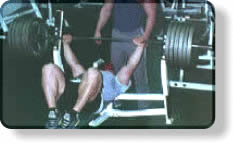
Click Here for Free Bodybuilding and Fitness Magazine Subscription
Bench Press More Than Body Weight

Click Here For The Best Bench Press Program
How To Bench Press More Than Your Body Weight
Research has now proved conclusively that the vast majority of men cannot bench-press their own bodyweight and over 80% of these men are not even close to pressing their own bodyweight. So we will be dealing with the necessary tips to get the pressing of at least 1.5 times your own bodyweight.
If you are someone who does not train with weights or bodyweight at all then you need to start thinking about joining a gym or planning a workout routine that you can do with your own bodyweight at home. The bench-press is and always has been the yardstick by which your upper body strength is measured.
Firstly it needs to be said that less is more when it comes to training and increasing the strength of your bench-press. What that means if you are thinking that if 3 sets of 10 reps for your bench-press is good and 6 sets is better then you are falling into a very common trap that many weight trainers fall into and that is over training.
When training with weights you need to always be aware of over-training and to be on the lookout constantly for signs of overtraining. The basic signs of overtraining are a general lack of motivation, trouble sleeping, poor nutrition, and of course lack of progress.
The second point which has proven itself to be important when increasing the strength of your bench-press is training on a split routine. You constantly need to remember that there's more to the bench press than just your chest. To achieve the maximum recovery you should only train each body part once per week with an optimal workout split.
Good form when doing a bench-press is vitally important and here are a few pointers to help you get the best out of your bench-press. The first thing that you should do is widen your grip a little bit. Simply because the wider your grip is the less distance the barbell has to travel.
If you have been benching with a closer grip then pressing with a wider grip will take some getting used to, but if you stick to it for a few weeks it will make a big difference. To determine your grip, assume a natural push-up position and then bump it out approximately 3-inches.
You can also use another technique to decrease the distance the bar has to travel and that is to retract your shoulder blades. You do this by trying to squeeze your shoulder blades together during the entire movement. This will give you a more stable surface to bench from.
You also need to keep your feet on the floor and drive with your heels. If you see someone kicking or flapping their legs in the air, as they turn blue trying to push the weight you'll know that they are off centered and it's costing them some serious poundage. Keep your heels on the floor to help you generate power.
The last point is to make sure that you always are arching your back when you bench-press. Your butt, shoulder blades, and your head should always be in contact with the bench, but it's okay to arch your lower back. If this does not feel natural for you, you can place a foam roller under your lower back for practice. (Note: A vibrating foam roller is also a great way to relieve sore muscles.) Arching your back will shorten the distance the bar needs to travel.
For more information click on the link below:

